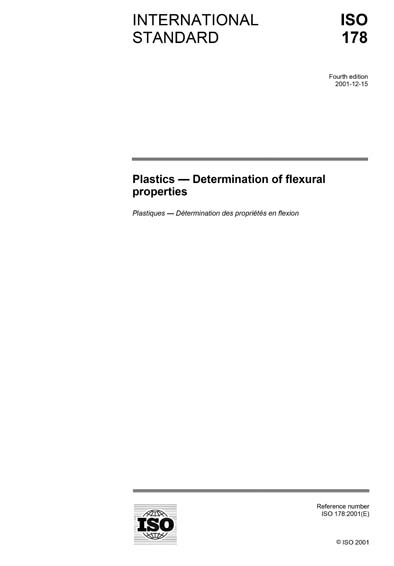Historical
ISO 178:2001
Plastics - Determination of flexural properties
This International Standard specifies a method for determining the flexural properties of rigid (see 3.12) and semi-rigid plastics under defined conditions. A standard test specimen is defined, but parameters are included for alternative specimen sizes for use where appropriate. A range of test speeds is included.
The method is used to investigate the flexural behaviour [1] of the test specimens and for determining the flexural strength, flexural modulus and other aspects of the flexural stress/strain relationship under the conditions defined. It applies to a freely supported beam, loaded at midspan (three-point loading test).
The method is suitable for use with the following range of materials:
- thermoplastics moulding and extrusion materials, including filled and reinforced compounds in addition to unfilled types; rigid thermoplastics sheets;
- thermosetting moulding materials, including filled and reinforced compounds; thermosetting sheets.
In agreement with ISO 10350-1 and ISO 10350-2, this International Standard applies to fibre-reinforced compounds with fibre lengths ≤ 7,5 mm prior to processing. For long-fibre-reinforced materials (laminates) with fibre lengths > 7,5 mm, see reference [2] in the bibliography.
The method is not normally suitable for use with rigid cellular materials and sandwich structures containing cellular material [3, 4].
The method is performed using specimens which may be moulded to the specified dimensions, machined from the central portion of a standard multipurpose test specimen (see ISO 3167) or machined from finished or semi-finished products such as mouldings, or extruded or cast sheet.
The method specifies preferred dimensions for the test specimen. Tests which are carried out on specimens of different dimensions, or on specimens which are prepared under different conditions, may produce results which are not comparable. Other factors, such as the test speed and the conditioning of the specimens, can also influence the results. Especially for semi-crystalline polymers, the thickness of the oriented skin layer, which is dependent on moulding conditions and thickness, affects the flexural properties. Consequently, when comparable data are required, these factors must be carefully controlled and recorded.
Flexural properties can only be used for engineering design purposes for materials with linear stress/strain behaviour. For non-linear behaviour, the flexural properties are only nominal. The bending test should preferentially be used with brittle materials, for which tensile tests are difficult.
Content Provider
International Organization for Standardization [iso]






